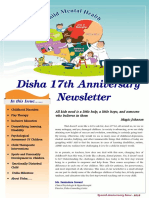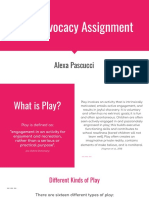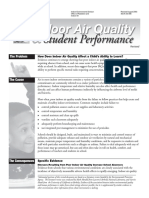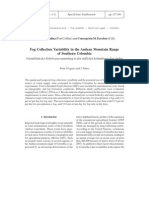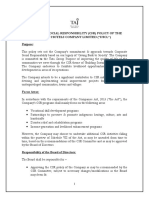0 ratings0% found this document useful (0 votes)
20 viewsAdhd Play Therapy
Adhd Play Therapy
Uploaded by
Mahmut tuncerThe document discusses the design of an interactive tabletop system called Magic Land to support non-directive play therapy for children with Attention Deficit Hyperactivity Disorder (ADHD). It provides an overview of non-directive play therapy principles and how Magic Land was designed with different applications to align with these principles and support children with cognitive limitations by guiding their technology use in a therapeutic way.
Copyright:
© All Rights Reserved
Available Formats
Download as PDF, TXT or read online from Scribd
Adhd Play Therapy
Adhd Play Therapy
Uploaded by
Mahmut tuncer0 ratings0% found this document useful (0 votes)
20 views4 pagesThe document discusses the design of an interactive tabletop system called Magic Land to support non-directive play therapy for children with Attention Deficit Hyperactivity Disorder (ADHD). It provides an overview of non-directive play therapy principles and how Magic Land was designed with different applications to align with these principles and support children with cognitive limitations by guiding their technology use in a therapeutic way.
Original Title
ADHD PLAY THERAPY
Copyright
© © All Rights Reserved
Available Formats
PDF, TXT or read online from Scribd
Share this document
Did you find this document useful?
Is this content inappropriate?
The document discusses the design of an interactive tabletop system called Magic Land to support non-directive play therapy for children with Attention Deficit Hyperactivity Disorder (ADHD). It provides an overview of non-directive play therapy principles and how Magic Land was designed with different applications to align with these principles and support children with cognitive limitations by guiding their technology use in a therapeutic way.
Copyright:
© All Rights Reserved
Available Formats
Download as PDF, TXT or read online from Scribd
Download as pdf or txt
0 ratings0% found this document useful (0 votes)
20 views4 pagesAdhd Play Therapy
Adhd Play Therapy
Uploaded by
Mahmut tuncerThe document discusses the design of an interactive tabletop system called Magic Land to support non-directive play therapy for children with Attention Deficit Hyperactivity Disorder (ADHD). It provides an overview of non-directive play therapy principles and how Magic Land was designed with different applications to align with these principles and support children with cognitive limitations by guiding their technology use in a therapeutic way.
Copyright:
© All Rights Reserved
Available Formats
Download as PDF, TXT or read online from Scribd
Download as pdf or txt
You are on page 1of 4
Designing for Attention Deficit Hyperactivity Disorder in
Play Therapy: the case of Magic Land
Olga Pykhtina1, Madeline Balaam2, Gavin Wood2, Sue Pattison1, Patrick Olivier2
School of Education, Communication Culture Lab
& Language Sciences School of Computing Science
Newcastle University, UK Newcastle University, UK
{olga.pykhtina/susan.pattison}@ncl.ac.uk {gavin.wood/Madeline.balaam/p.l.olivier}@ncl.ac.uk
ABSTRACT Hyperactivity Disorder (ADHD) suffering difficulties with
We report on Magic Land, a package of play activities on memory and concentration. The overview of the
an interactive tabletop, designed to support non-directive encountered problems is given. Finally, we speculate on
play therapy with children. In our use-case we discuss how design systems that are aligned with play therapy
children suffering symptoms of Attention Deficit principles and, at the same time, support children with
Hyperactivity Disorder. Drawing on this experience we cognitive limitations by guiding their technology use.
speculate on design guidelines for systems that aim to
support children experiencing problems with memory,
concentration and attention in play therapy.
Author Keywords
Play therapy; cognitive limitations; design; children.
ACM Classification Keywords
H5.m. Information interfaces and presentation (e.g., HCI):
Miscellaneous.
INTRODUCTION
Digital technology is a familiar media in children's lives.
Video games and virtual reality applications in particular
have already been successfully deployed in psychotherapy
to treat a range of anxiety, panic disorders and phobias [3].
Digital technologies, however, are largely absent in non-
directive therapies with young children. Therapists are Figure 1. The Magic Land interactive tabletop prototype
concerned that technology may interrupt child/therapist PLAY THERAPY
relationship and frustrate the child, if not working properly. Play therapy is defined as a form of self-therapy for
Yet, there is little evidence that supports these concerns. children through which confusion, anxieties and conflicts
Interactive tabletops constitute a new generation of digital are worked through [4]. Since children’s language
technology that allows for direct interaction through a development lags behind their emotional and abstract
horizontal multi-touch surface. They have been used to abilities to conceptualize the world in which they live [2],
promote children's fantasy play, storytelling, creativity, and toys and other manipulative tangibles are used in play
collaborative interaction [5]. Although play therapy is based therapy as a way of helping children communicate their
upon these elements, there is little research on the use of ideas and feelings. Play therapy can be used with any child
interactive tabletops in play therapy. to help them modify their behaviors, clarify self-concepts
and build healthy relationships. In simple terms we can
In this paper we present Magic Land, a package of play think of it as equivalent to what counseling is for adults [6].
activities designed for the use with primary school children
Non-directive Approach to Play Therapy
in non-directive play therapy. We further discuss a case of
Non-directive play therapy is based on the belief that within
the use of Magic Land with two children, who in addition to
each person is a powerful force that strives for complete
emotional problems were diagnosed with Attention Deficit
self-realization [2]. This is manifested in each individual’s
desire to gain maturity, independence and self-direction.
Permission to make digital or hard copies of all or part of this work for Therefore, in non-directive play therapy it is essential to
personal or classroom use is granted without fee provided that copies are create space for the child to have full freedom to lead and
not made or distributed for profit or commercial advantage and that copies
bear this notice and the full citation on the first page. To copy otherwise, control the therapeutic process without the therapist
or republish, to post on servers or to redistribute to lists, requires prior providing any direction or guidance.
specific permission and/or a fee.
DIS 2012, June 11-15, 2012, Newcastle, UK.
Copyright 2012 ACM 978-1-4503-1210-3/12/06...$10.00.
To facilitate the therapeutic process, however, the therapist Flying Feathers: Supporting Expression
is required to establish warm and friendly relationship; Flying Feathers responds to non-directive play therapy
unconditional acceptance of the child; opportunity for the principles of Unconditional Acceptance and Feeling of
child to express feelings without fear; reflection of feelings Permissiveness to Express Anything by supporting a child’s
back to the child; returning responsibility to the child; creative expression through painting, drawing, mixing
letting the child lead; recognition of the gradual nature of colours and creating scenes in picture frames. These options
therapeutic process; setting of only necessary limits [2]. allow the child to make art in the presence of the therapist,
which enables a child to connect with their feelings and
Use of Non-Directive Play Therapy
particularly those that cannot be easily expressed in words
Non-directive play therapy has been shown to be an
[9]. We provided a wide palette so the child could identify
effective intervention for children with a number of
with and express a broad range of feelings.
problems including anxiety, depression, medical illness,
post-traumatic stress disorder and attachment problems [8]. Rosebush: Supporting Role-Play
In addition, it is successfully used with children suffering Following a non-directive approach Rosebush supports
autism, mental retardation and Attention Deficit role-play, evoking a Feeling of Permissiveness to Express
Hyperactivity Disorder (ADHD) [8]. Non-directive play Anything, another core principle of non-directive play
therapy is an effective intervention to improve therapy. In this toy, images of trees, flowers and animals
relationships, self-concept and feeling of frustration [10]. become the child’s language, allowing a child to create
environments and stories and, thus, to explore
ATTENTION DEFICIT HYPERACTIVITY DISORDER
understandings and feelings of real life events.
Attention Deficit Hyperactivity Disorder is a condition
usually developed in early childhood that is characterized Hero/Avatar: Supporting Imaginative Play
by significant problems with attention, impulsiveness and Hero/Avatar supports the child’s creative expression and
excessive activity [1]. The number of symptoms can be imaginative play. To support Feeling of Permissiveness to
broadly divided into three categories: inattention, Express Anything it is valuable to empower the child
impulsivity and hyperactivity. through imaginative creative play with avatars and
superheroes. Rather than providing a set of already made
Inattention symptoms include the child’s inability to finish famous superheroes (e.g. Batman or Wonder woman)
the task, difficulty concentrating or sticking to one activity, Hero/Avatars encourages further creativity by enabling the
failure to listen and follow what is being said. Impulsivity child to create their own hero.
is being observed when the child acts before giving it a
thought; has difficulty organizing his time and work; needs Water: Supporting New Play Opportunities
a lot of supervision; has difficulties awaiting turns in The final application in Magic Land, Water, focuses on
games. Running about or climbing on things excessively, non-directive play therapy principle of Returning
difficulty staying seated, and being always ‘on the go’ are Responsibility to the Child by again creating opportunities
signs of hyperactivity. Children with ADHD symptoms can for play that cannot be offered in a traditional play therapy
be described as excessively emotional, often experiencing room environment. The Water application allows the child
anxiety and behavioral problems [1]. to joyfully play with water. We created opportunities for the
child to make ripples, add pebbles and various stones, ships,
MAGIC LAND shells etc. We also combined it with the sounds of rain and
Magic Land (Figure 1) consists of four toys implemented as thunder and corresponding visual effects created on the
an integrated suite of multi-touch applications on a SMART surface of the water to explore the possibility and potential
Table: Flying Feathers to support creative and emotional benefits of bringing music and play therapy together.
expression, Rosebush to support storytelling, Hero/Avatars
to support fantasy play and Water to support new play CHALLENGES OF MAGIC LAND
opportunities. (Full description of Magic Land design and Although the Magic Land wasn’t designed specifically for
evaluation can be found in [7]). A child can open each the use with children suffering cognitive limitations, we
specific toy from the “home” screen by pressing on an present below two cases of children, who in addition to
image that represents the toy. An exit button on the right emotional problems, were diagnosed with ADHD suffering
top corner of the screen allows the child to return to “home” difficulties with memory and concentration (names are
at any time. changed for ethical reasons).
In contrast to a lot of commercial children’s video games, Case 1: Mark
the application is designed as a non-goal oriented virtual Mark, a 6-year-old boy diagnosed with ADHD, was
environment where the child has freedom to choose among referred for play therapy sessions to work through his
such activities as drawing; mixing colors; using background anxiety and behavior problems. Usually, Mark found it
pictures and characters; options to create a hero or an difficult to concentrate on any activity for a definite period
avatar; play with fire, water, snowflakes and rain. of time and seemed quite fearful to try new things if his first
attempts failed.
The simplicity of the Magic Land interface ensured that the sessions. It seems that those two children diagnosed with
system could be easily used without the therapist’s ADHD engaged more with the applications designed for
guidance or instructions. Mark’s impulsive hand emotional and creative expression (Flying Feathers and
movements on the table, however, made it difficult for the Water). Hero/Avatar and Rosebush applications, designed
system to respond appropriately which often led to to encourage storytelling and imaginative play, on the
‘freezing’ and the need to restart the tabletop. This resulted contrary, received much less attention from the children. In
into Mark being frustrated and discouraged from the play light of this, we propose two directions for the future
on the table. He would switch to using tangible toys for system designs
some time and then go back to play with the Magic land.
Further Encouragement of Emotional and Creative Play
Mark’s interest in technology served as a motivating factor Since children with ADHD experience difficulties
that encouraged him to keep the focus on his play. His maintaining focus on one task and processing information
parents noted in the conversation with the therapist that as quickly and accurately as others, they may benefit more
playing on the interactive tabletop was the longest activity from play that enables expression of feelings and creativity
that they saw him focused on in a long time. Interestingly, in a way that does not require much time commitment,
Mark seemed to adjust his speed of play on the table in concentration or complex cognitive abilities. For example,
order to avoid problems with computer freezing. It could be playing on an interactive tabletop with natural forces like
due to his interest in technology and desire to play on this wind, sun and rain or ‘conjuring’ a storm can help the child
new medium that encouraged him to adjust his own pace. work through their emotions and fears in a metaphorical
way.
In his sessions, Mark mainly used Flying Feathers and
Water applications that were designed for creative and For this type of play it is important that the surface of an
emotional expression. Perhaps not surprising that Rosebush interactive tabletop is highly responsive. Otherwise, the
and Hero/Avatar were used considerably less, compared to child can get frustrated and discouraged which would
the children in the study, who did not have ADHD, as these interrupt the therapeutic process rather than support it. We
applications would involve more slowly play and cognitive recommend introducing music, noises and sounds to the
involvement on the child’s behalf. system. Calming effect of rain and bird singing has already
been proven beneficial in our study. Since children with
Case2: Jenny
ADHD tend to be impatient, it is essential to provide
Jenny, 8-year-old girl used the Magic Land in her play
sounds that can sooth child’s hyperactive state. Computer
therapy sessions. Similarly to Mark, Jenny was diagnosed
freezing is another issue to be seriously considered. The
with ADHD and referred to therapy to work through her
system should be sturdy enough and have a back up in case
tantrum behavior and fears.
the child’s work is lost.
On a few occasions the therapist noted that Jenny liked New Ways of Supporting Child’s Cognitive Abilities in
Hero/Avatar and Rosebush applications the least of all. It is Therapy
hard to say why she avoided creating stories and scenes. It Here we consider ways and strategies to support child’s
could be possibly explained by her struggle to think expression if play involves such abilities as good memory,
abstractly to recall where the images she would need are. focus and attention.
Also, storytelling activity requires time commitment and
focus, which she found difficult: ‘…I don’t know if it’s As our experience shows, to enable the child to create
because she’s ADHD so may be its not going fast enough stories in a therapeutic context, instructions are needed to
for her…’ (T2). guide and support the child. According to non-directive
play therapy principles, the direction has to come from the
Jenny did a lot of explorative and expressive play using child, which means that the therapist cannot even offer help
Magic Land. She would use her cheeks and ears to draw on until explicitly asked. Since, non-directive play therapy
the surface of the table. She also enjoyed playing with aims to encourage the child’s sense of mastery and
Water because ‘…it’s calming…and even the sound, you empowerment it is necessary to provide toys and materials
know, can make it just a little bit louder…when the sound is which can be easily used.
on [it’s like] you’re playing in the water’ (T2).
To meet this challenge, some of the therapists suggest
In addition, the child spent much of the time re-sizing, having the instructions incorporated into the system in the
rotating and vanishing images off the screen. It seemed that form of an animated character. The child, in this case, will
she enjoyed non-goal oriented environment of Magic Land have full control of what and how to ask the animated
that enabled her being in control and making her own character, which would not interfere with therapist/child
decisions about her play. relationship. In addition, this guidance can keep children
SPECULATIONS ON DESIGN GUIDELINES with ADHD focused and interested in the play activity.
In the previous section we presented a quick overview of Another way of supporting the child in storytelling is
the children’s play with Magic Land in play therapy through creating short instructional videos. The video of
someone making stories on an interactive tabletop could be difficulties with memory, focus and concentration in the
available for the child in their therapy sessions. It could context of play therapy.
remind them of what options they can use and what is
REFERENCES
possible in Magic Land or similar application. 1. Barkley, R., and Murphy, K. Attention-Deficit
We would not recommend adding prompts or other Hyperactivity Disorder: A Clinical Workbook, Volume
attention catching options into the system unless it is to be 2. New York: Guilford Press, 2006
used within more directive approaches to play therapy. If, 2. Carmichael, K. Play Therapy: An Introduction, Pearson,
however, applications are designed within directive therapy New Jersey, 2006
framework, structure and guidance are highly encouraged.
An application in such a case, could present a goal-oriented 3. Coyle, D., Doherty, G. Clinical evaluations and
environment enabling the child to make a step-by-step collaborative design: developing new technologies for
story. Such guided approach could prevent the child from mental healthcare interventions. CHI 2009, ACM Press,
getting overwhelmed with many options and images (2009), 2051–2060
presented in the system. In addition, it may help control the 4. Hall, T.M., Kaduson, H.G., and Schaefer C.E. Fifteen
child’s impulsive play that leads to computer ‘freezing’. Effective Play Therapy Techniques. Professional
Psychology: Research and Practice, (2002), 515-522.
Also, guidance could be beneficial if the system reacted to
the child’s inactivity on an interactive tabletop. For 5. Marco J., Cerezo, E., Baldassarri, E., Mazzone E., and
example, if the child stopped playing for a considerate Read J.C. Bringing tabletop technologies to
period of time, the system could give a prompt in a way of a kindergarten children. In Proc. HCI (2009), 103-111.
sound, image or verbal invitation to continue play. We 6. Pykhtina, O., Balaam, M., Pattison, S., Wood, G., and
would recommend providing the child with diverse options Olivier, P. Magic Land: Play Therapy on Interactive
(e.g. through combining tangible toys and digital Tabletops, In Proc. CHI (2012), Upcoming, Austin,
environment on an interactive tabletop) to avoid the child Texas: ACM
getting bored quickly. We find interactive tabletops more
7. Pykhtina, O., Balaam, M., Pattison, S., Wood, G., and
suitable for child’s play than traditional computers as they
Olivier, P. Magic Land: the design and evaluation of an
allow for freedom of movement around them and easy
interactive tabletop supporting therapeutic play with
access to the screen from many angles.
children. In Proc. DIS (2012) Upcoming, Newcastle,
CONCLUSION UK: ACM
As we initially argued, there is lack of exploratory studies 8. VanFleet, R., Sywulak, A., Sniscak, C. Child-Centred
on the use of technology and interactive tabletops in play Play Therapy. New York: Guilford Press, 2010
therapy with primary school children. As such, our
development of design guidelines and our qualitative study 9. Waller, D. Art Therapy for Children: How It Leads to
of the use of Magic Land is a much-needed contribution to Change. Clinical Child Psychology and Psychiatry,
our understanding of how digital toys could be designed on SAGE Publication, (2006), 271-282
interactive tabletops. 10. Wilson K., and Ryan V. Play Therapy: A Non-Directive
Approach for Children and Adolescents, 2nd ed.
We have drawn on our experience of using Magic Land
Oxford, 2005
with children suffering ADHD and speculated on how
systems could be designed to support children experiencing
You might also like
- Pogil Heat and CalorimetryDocument4 pagesPogil Heat and Calorimetryapi-341706426No ratings yet
- C39 - Fraud Awareness and Prevention - 2015 - AddendumDocument3 pagesC39 - Fraud Awareness and Prevention - 2015 - AddendumNidhi KatyalNo ratings yet
- Adlerian Play TherapyDocument12 pagesAdlerian Play TherapyAura AtheneuNo ratings yet
- 3 - Sievert-Play Therapy in The School Setting PGCADocument50 pages3 - Sievert-Play Therapy in The School Setting PGCAJoseph Alvin PeñaNo ratings yet
- Play Therapy (Report Outline)Document4 pagesPlay Therapy (Report Outline)Jan Michael Suarez100% (1)
- Play Therapy With Abuse ChildrenDocument6 pagesPlay Therapy With Abuse ChildrenAnonymous uMODD2cNo ratings yet
- 17th Anniversary NewsletterDocument16 pages17th Anniversary NewsletterDisha Counseling CenterNo ratings yet
- Play Therapy ManualDocument119 pagesPlay Therapy ManualScribdTranslationsNo ratings yet
- Healing Through PlayDocument2 pagesHealing Through PlayEunice KhainzaNo ratings yet
- Play Therapy: DefinitionDocument11 pagesPlay Therapy: DefinitionSeema Yadav100% (1)
- Play TherapyDocument8 pagesPlay TherapyHai TuNo ratings yet
- A8. Creative DramaDocument16 pagesA8. Creative DramaFrancis A. BuenaventuraNo ratings yet
- Cap2 23 32Document10 pagesCap2 23 32Elcio PradoNo ratings yet
- Play TherapyDocument2 pagesPlay TherapyravensuichiroNo ratings yet
- Play Therapy in PsychiatryDocument10 pagesPlay Therapy in PsychiatryMadhumitha.RNo ratings yet
- Play Therapy FinalDocument8 pagesPlay Therapy FinalChandru KowsalyaNo ratings yet
- Hira Abbasi Assignment (Play Therapy)Document8 pagesHira Abbasi Assignment (Play Therapy)Hira AbbasiNo ratings yet
- Play Therapy by Rita Mae ReyesDocument6 pagesPlay Therapy by Rita Mae ReyesPrincess Gutierrez RositaNo ratings yet
- Play Therapy Considerations and Applications Fir The PractitionerDocument6 pagesPlay Therapy Considerations and Applications Fir The PractitionerDiana IgnatNo ratings yet
- Warreyn VanderPaelt DMCN2014Document12 pagesWarreyn VanderPaelt DMCN2014khadidja BOUMEGOUASNo ratings yet
- Bijnr 202427Document7 pagesBijnr 202427editorbijnrNo ratings yet
- Informal Assessment For ChildrenDocument24 pagesInformal Assessment For Childrenayesha kamalNo ratings yet
- Assignment On Play TherapyDocument6 pagesAssignment On Play TherapySoraisham Kiranbala DeviNo ratings yet
- Art and Play Therapy WordDocument6 pagesArt and Play Therapy WordmominNo ratings yet
- Play TherapyDocument4 pagesPlay Therapynaziaimam62No ratings yet
- Prendiville (2014) Cap 6Document14 pagesPrendiville (2014) Cap 6mafernandaap.12No ratings yet
- Behaviour and Classroom Management EDocument71 pagesBehaviour and Classroom Management EAfif MansorNo ratings yet
- Ecn Nov 2021Document2 pagesEcn Nov 2021api-239011467No ratings yet
- Play TherapyDocument28 pagesPlay TherapyVishu100% (6)
- Chapter 6 - Autism Spectrum DisorderDocument5 pagesChapter 6 - Autism Spectrum DisordershakibazankiNo ratings yet
- Social &emotional DevelopmentDocument5 pagesSocial &emotional DevelopmentDeborahl aaronNo ratings yet
- Jungian Sept2019 FINALDocument3 pagesJungian Sept2019 FINALMolly ChristensenNo ratings yet
- Play Therapy - What Is It, How It Works, and TechniquesDocument18 pagesPlay Therapy - What Is It, How It Works, and TechniquesEunice KhainzaNo ratings yet
- What Is Play Therapy 4175560Document6 pagesWhat Is Play Therapy 4175560Eunice KhainzaNo ratings yet
- JBC-Article-Vol-35-Issue-2 5-Building Bridges With Kids Using Expressive Activities-LoweDocument17 pagesJBC-Article-Vol-35-Issue-2 5-Building Bridges With Kids Using Expressive Activities-LowetghsilvaNo ratings yet
- Zzzzzzfacial Expression Recognition Teaching To PreschoolersDocument8 pagesZzzzzzfacial Expression Recognition Teaching To PreschoolersAntonioNo ratings yet
- Play Therapy - PMCDocument12 pagesPlay Therapy - PMCSrishti ChelwaniNo ratings yet
- Final Module PresenattionDocument33 pagesFinal Module Presenattionmandira fernandoNo ratings yet
- Sensori Integrasi Theory - 3 - Ayres1998Document6 pagesSensori Integrasi Theory - 3 - Ayres1998Grendly AlaseNo ratings yet
- Communicating With ChildrenDocument18 pagesCommunicating With ChildrenAlmira CayeNo ratings yet
- Play TherapyDocument14 pagesPlay TherapyArsi SharmaNo ratings yet
- Artigo 40 PDFDocument6 pagesArtigo 40 PDFFelipe FookNo ratings yet
- Year 3, Module 1, Component 2 EssayDocument5 pagesYear 3, Module 1, Component 2 EssaymichaelaNo ratings yet
- Psychotherapy - Written ReportDocument18 pagesPsychotherapy - Written ReportianneNo ratings yet
- The Introduction of Attachment Play in Child and Family Social Work Optimizing Connection, Emotional Release & Supporting Challenging BehavioourDocument10 pagesThe Introduction of Attachment Play in Child and Family Social Work Optimizing Connection, Emotional Release & Supporting Challenging BehavioourAlina van MeerNo ratings yet
- Treatments of AutismDocument2 pagesTreatments of AutismseemabNo ratings yet
- Emotional Inteligence Children Special NeedsDocument2 pagesEmotional Inteligence Children Special Needscristian prisecaruNo ratings yet
- HBEC 3303 Play Therapy in Early Childhood Education AssignmentDocument8 pagesHBEC 3303 Play Therapy in Early Childhood Education AssignmentTan Yee Kean100% (1)
- Unit 2 - Paper 1Document10 pagesUnit 2 - Paper 1Tanvi ManjrekarNo ratings yet
- Play Advocacy AssignmentDocument22 pagesPlay Advocacy Assignmentapi-639912537No ratings yet
- MODULE 22: Cognitive Development of Intermediate Schoolers: Longer Span, Interest Is Necessary)Document2 pagesMODULE 22: Cognitive Development of Intermediate Schoolers: Longer Span, Interest Is Necessary)Darlyn BangsoyNo ratings yet
- Empowering Autistic VoicesDocument24 pagesEmpowering Autistic VoicespsychaidconsultsNo ratings yet
- Story Telling Counseling As Technique For Manage Stress in Marginal ChildrenDocument5 pagesStory Telling Counseling As Technique For Manage Stress in Marginal Childrengesharahmalia60No ratings yet
- PlayTherapy With Abused Children PDFDocument6 pagesPlayTherapy With Abused Children PDFAnonymous uMODD2cNo ratings yet
- Play TherapyDocument7 pagesPlay TherapyBhAVya 27No ratings yet
- HCD Term 2 PreschoolDocument7 pagesHCD Term 2 PreschoolANDEELA IQBALNo ratings yet
- Kmu Therapeutic Play & CommunicationDocument26 pagesKmu Therapeutic Play & CommunicationSHAFIQNo ratings yet
- The Therapeutic Use of Self-ParentsDocument17 pagesThe Therapeutic Use of Self-ParentssepthyaniNo ratings yet
- Nurturing Emotional Intelligence in Children: A Comprehensive Guide."From EverandNurturing Emotional Intelligence in Children: A Comprehensive Guide."No ratings yet
- Playtherapy No Small ChangeDocument7 pagesPlaytherapy No Small ChangeAniriiiNo ratings yet
- Introduction To Play TherapyDocument10 pagesIntroduction To Play TherapyJan Michael Suarez100% (1)
- Raising Resilient Neurodiverse Kids: Empowering Parents with Practical Strategies for ADHD, Autism, and BeyondFrom EverandRaising Resilient Neurodiverse Kids: Empowering Parents with Practical Strategies for ADHD, Autism, and BeyondNo ratings yet
- Monzo - Bank - Statement - 2024 06 01 2024 06 18 - 5131Document3 pagesMonzo - Bank - Statement - 2024 06 01 2024 06 18 - 5131jasmeetkaur0075No ratings yet
- Poverty CSSDocument7 pagesPoverty CSSsohailbabarNo ratings yet
- RPT - 39 Page 52 - 101Document50 pagesRPT - 39 Page 52 - 101lagianggenNo ratings yet
- Indoor Air Quality and Student PerformanceDocument8 pagesIndoor Air Quality and Student Performancesunnews820No ratings yet
- Fog Water Harvesting in The Andean Mountain RangeDocument14 pagesFog Water Harvesting in The Andean Mountain RangeGreen Action Sustainable Technology GroupNo ratings yet
- Data SheetDocument2 pagesData SheetMartínNo ratings yet
- Surface Design Sample Book 1 Chew-Compressed 1-CompressedDocument94 pagesSurface Design Sample Book 1 Chew-Compressed 1-Compressedapi-687324690No ratings yet
- Hands-On BOP Workshop: Authors: Jaap Peetsold and Anton GreeffDocument8 pagesHands-On BOP Workshop: Authors: Jaap Peetsold and Anton GreeffKaleem UllahNo ratings yet
- Turbidity Test Unit: Data SheetDocument1 pageTurbidity Test Unit: Data SheetGoran PanticNo ratings yet
- Grade 12 Economics - Economic Turmoil AssignmentDocument3 pagesGrade 12 Economics - Economic Turmoil AssignmentDom DesmaraisNo ratings yet
- Energy Conversion X-Former Transformation RatioDocument7 pagesEnergy Conversion X-Former Transformation RatioOve KhanNo ratings yet
- 0010T20 Engine Coolant - ChangeDocument4 pages0010T20 Engine Coolant - Changeendoscopia.biosondaNo ratings yet
- Ihcl CSR PolicyDocument4 pagesIhcl CSR PolicyBhomik J ShahNo ratings yet
- Waves and Tidal Energy Tutorial LatestDocument3 pagesWaves and Tidal Energy Tutorial LatestAdreana AmirahNo ratings yet
- Mono Acting (JRS) Guidelines - 2024-25Document1 pageMono Acting (JRS) Guidelines - 2024-25Amisha DalalNo ratings yet
- Electrical WorksDocument16 pagesElectrical WorkskrmcharigdcNo ratings yet
- 1 What Is Development and ClassificationDocument33 pages1 What Is Development and Classificationjavier.mayor83No ratings yet
- E-Katalog Lokal Tayang SNG 2024Document2 pagesE-Katalog Lokal Tayang SNG 2024rizki gilarnaNo ratings yet
- Phil286 Exam 3Document6 pagesPhil286 Exam 3Mochammad AndreNo ratings yet
- Tes Kepribadian FlorenceDocument59 pagesTes Kepribadian FlorenceMarcella Mariska AryonoNo ratings yet
- GCB & GAH (1) AhmedDocument1 pageGCB & GAH (1) AhmedardalanNo ratings yet
- " Genome Editing ": Pr. AttarcaDocument20 pages" Genome Editing ": Pr. AttarcameryemNo ratings yet
- Product Information - Healthcare Insurance Employee HandbookDocument20 pagesProduct Information - Healthcare Insurance Employee Handbookrestoreal.mechworkshopNo ratings yet
- Cancer - The Real Truth Written and Edited by M.RDocument10 pagesCancer - The Real Truth Written and Edited by M.RMark RostronNo ratings yet
- Group 2 - Week 5 - Enterprise Risk Management FrameworkDocument21 pagesGroup 2 - Week 5 - Enterprise Risk Management FrameworkTiara Indah SariNo ratings yet
- Design Number 3MU/BPF 180-01: Perimeter Fire BarriersDocument2 pagesDesign Number 3MU/BPF 180-01: Perimeter Fire BarriersAbram SelimNo ratings yet
- Disaster Monitoring ReportDocument9 pagesDisaster Monitoring ReportJane BonggoNo ratings yet
- Masterlist of Teaching and Non Teaching For HealthDocument8 pagesMasterlist of Teaching and Non Teaching For HealthJasmin Kerre VillarinNo ratings yet






